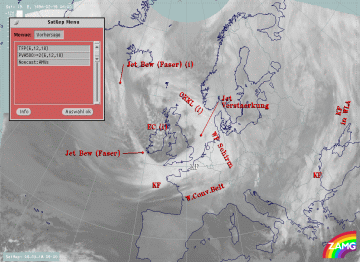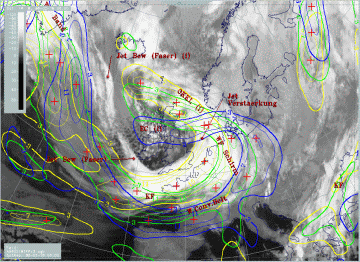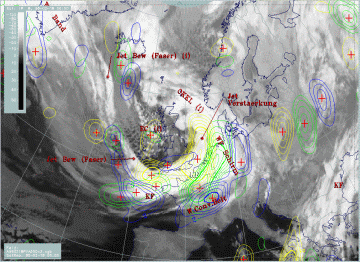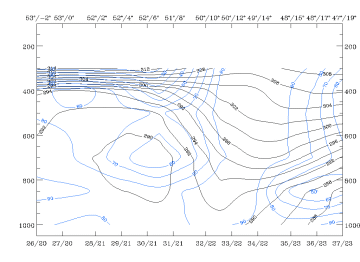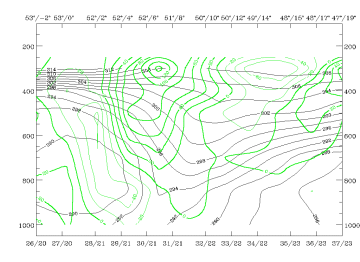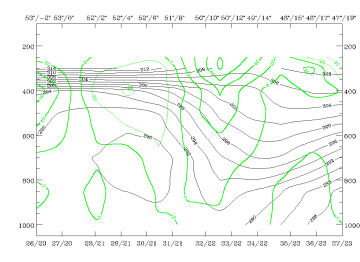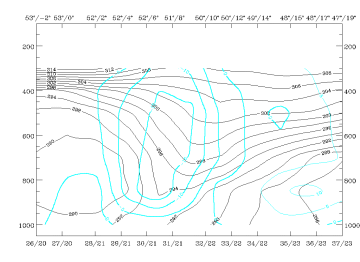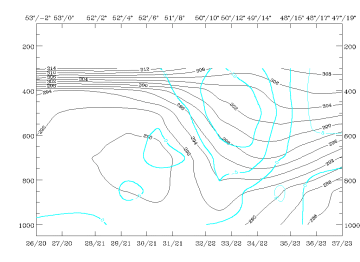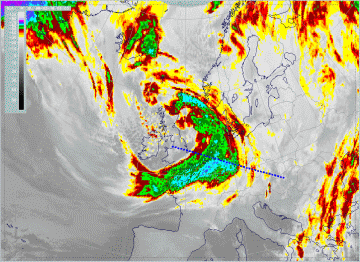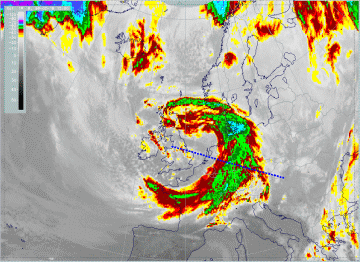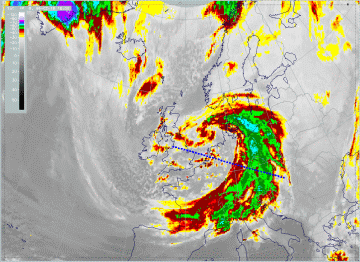18 - 19 February 1996 - Forecast For The Cold Front For 18 February 12.00 UTC And 18.00 UTC
|
18 February 1996/06.00 UTC - Meteosat IR image; SatRep overlay: names of conceptual models; SatRep menu: key parameters for Cold Front
forecast
|
|
Concerning the forecast of the conceptual model "Cold Front" in the SatRep Menu, a button "Vorhersage" (= forecast) has to be clicked on and the relevant menu appears. As can be seen in the right upper corner, two kinds of forecasts and forecast intervals are presented:
The very short range forecast VSRF (06.00 - 18.00 UTC, 12 hours)
For the very short range forecast, six-hourly forecasts from ECMWF are used, and those parameters which are key parameters of a conceptual model are prepared as overlays on the satellite image in three different colours, representing the three points of time 06.00, 12.00 and 18.00 UTC:
- yellow: 06.00 UTC
- green: 12.00 UTC
- blue: 18.00 UTC
Nowcasting (0-2 hours)
For this forecast interval atmospheric motion vectors (AMVs) are used which extrapolate the cloud systems for the next two hours. These nowcasts are renewed half-hourly or hourly and are not discussed here.
|
18 February 1996/06.00 UTC - Meteosat IR image; yellow: thermal front parameter (TFP) 500/850 hPa 06.00 UTC, green: thermal front
parameter (TFP) 500/850 hPa 12.00 UTC, blue: thermal front parameter (TFP) 500/850 hPa 18.00 UTC
|
|
For the frontal characteristics see cold front diagnosis for 06 UTC (compare Cold Front ).
The thermal front parameter indicating location of the Cold Front is propagating very fast from the west European coast to central France and west Germany at 12.00 UTC, and south France, Switzerland and Austria at 18.00 UTC.
Estimates about intensity changes of the cloudiness using the isoline distribution of the TFP can only be made very roughly. For this, the parameter of PVA at 500 hPa is much more appropriate.
|
18 February 1996/06.00 UTC - Meteosat IR image; yellow: positive vorticity advection (PVA) 500/850 hPa 06.00 UTC, green: positive
vorticity advection (PVA) 500/850 hPa 12.00 UTC, blue: positive vorticity advection (PVA) 500/850 hPa 18.00 UTC
|
|
As can be seen in this case, the main strong PVA maximum over the North Sea close to the Belgian coast is elongated and split into two maxima. The more northern one propagates into Germany while the second one moves quickly south-eastwards into France and Switzerland. Both maxima remain strong until 12.00 UTC and weaken from then on until 18.00 UTC.
Another forecast help is to inspect the vertical cross sections computed from ECMWF forecast fields. Besides providing information about propagation, this method has the advantage of gaining insight into the changes in the vertical structure of the frontal surface.
|
18 February 1996/06.00 UTC - Meteosat IR enhanced image; position of vertical cross section indicated
|
18 February 1996/06.00 UTC - Vertical cross section; black: isentropes (ThetaE), blue: relative humidity, orange thin: IR pixel values,
orange thick: WV pixel values
|
|
18 February 1996/12.00 UTC - Vertical cross section; black: isentropes (ThetaE), blue: relative humidity, orange thin: IR pixel values,
orange thick: WV pixel values
|
18 February 1996/18.00 UTC - Vertical cross section; black: isentropes (ThetaE), blue: relative humidity, orange thin: IR pixel values,
orange thick: WV pixel values
|
The line of the vertical cross section indicated in the satellite image cuts through the Cold Front, the warm sector and the southern parts of the Warm Front. The vertical cross sections of ThetaE (black lines) show the two frontal zones as inclined zones of high gradients. They clearly move eastward from 06.00 to 18.00 UTC merging somewhat. At 12.00 UTC ECMWF gridpoint 31/22 separates the two fronts at the ground level; at 18.00 UTC it is the gridpoint 33/22. The blue lines represent relative humidity and show an intensive wet zone on top of the two frontal zones and, consequently, also between them. Dry air can be seen only on top of the Cold Front zone but does not protrude downward to any great effect in this period.
All other parameters, especially PVA and vertical motion (Omega), indicate a continuously high intensity of the eastward-moving cold front for 12.00 and 18.00 UTC. The PVA field contains at 300 hPa a pronounced maximum which is superimposed on the frontal zone as well as on the cloudiness connected to it and moves eastward. Vertical motion shows a very intensive zone of upward motion (negative values of Omega) on top of the Cold Front surface; during an increasing inclination of the crowding zone of isentropes representing the Cold Front until 18.00 UTC, the maximum of vertical motion inclines in the same way.
|
18 February 1996/06.00 UTC - Vertical cross section; black: isentropes (ThetaE), green thick: vorticity advection - PVA, green thin:
vorticity advection - NVA, orange thin: IR pixel values, orange thick: WV pixel values
|
18 February 1996/12.00 UTC - Vertical cross section; black: isentropes (ThetaE), green thick: vorticity advection - PVA, green thin:
vorticity advection - NVA, orange thin: IR pixel values, orange thick: WV pixel values
|
|
18 February 1996/18.00 UTC - Vertical cross section; black: isentropes (ThetaE), green thick: vorticity advection - PVA, green thin:
vorticity advection - NVA, orange thin: IR pixel values, orange thick: WV pixel values
|
|
|
18 February 1996/06.00 UTC - Vertical cross section; black: isentropes (ThetaE), cyan thick: vertical motion (omega) - upward motion,
cyan thin: vertical motion (omega) - downward motion, orange thin: IR pixel values, orange thick: WV pixel values
|
18 February 1996/12.00 UTC - Vertical cross section; black: isentropes (ThetaE), cyan thick: vertical motion (omega) - upward motion,
cyan thin: vertical motion (omega) - downward motion, orange thin: IR pixel values, orange thick: WV pixel values
|
|
18 February 1996/18.00 UTC - Vertical cross section; black: isentropes (ThetaE), cyan thick: vertical motion (omega) - upward motion,
cyan thin: vertical motion (omega) - downward motion, orange thin: IR pixel values, orange thick: WV pixel values
|
A comparison of the images for 06, 12 and 18 UTC supports the conclusion that there is pronounced frontal activity of the Cold Front throughout this period of time. One additional and interesting fact can be derived from an inspection of the images: the rearward boundary of the Cold Front band which has lower cloud tops (yellow-red-brown) in comparison to the leading parts (green-blue) becomes larger until 18.00 UTC. This may be an indication of a transition from an Ana to a Kata Front type. ECMWF forecast parameters used with the vertical cross section, such as humidity or isotachs do not show this change clearly.
|
18 February 1996/06.00 UTC - Meteosat IR enhanced image; position of vertical cross section indicated
|
18 February 1996/12.00 UTC - Meteosat IR enhanced image; position of vertical cross section indicated
|
|
18 February 1996/18.00 UTC - Meteosat IR enhanced image; position of vertical cross section indicated
|
